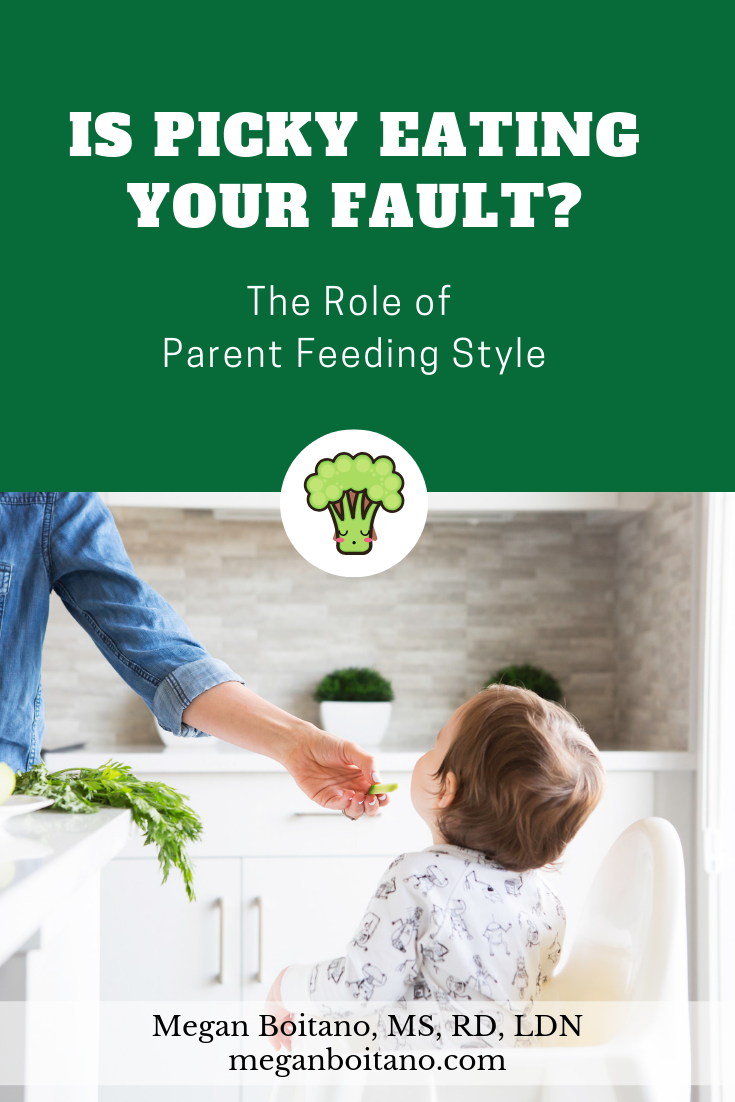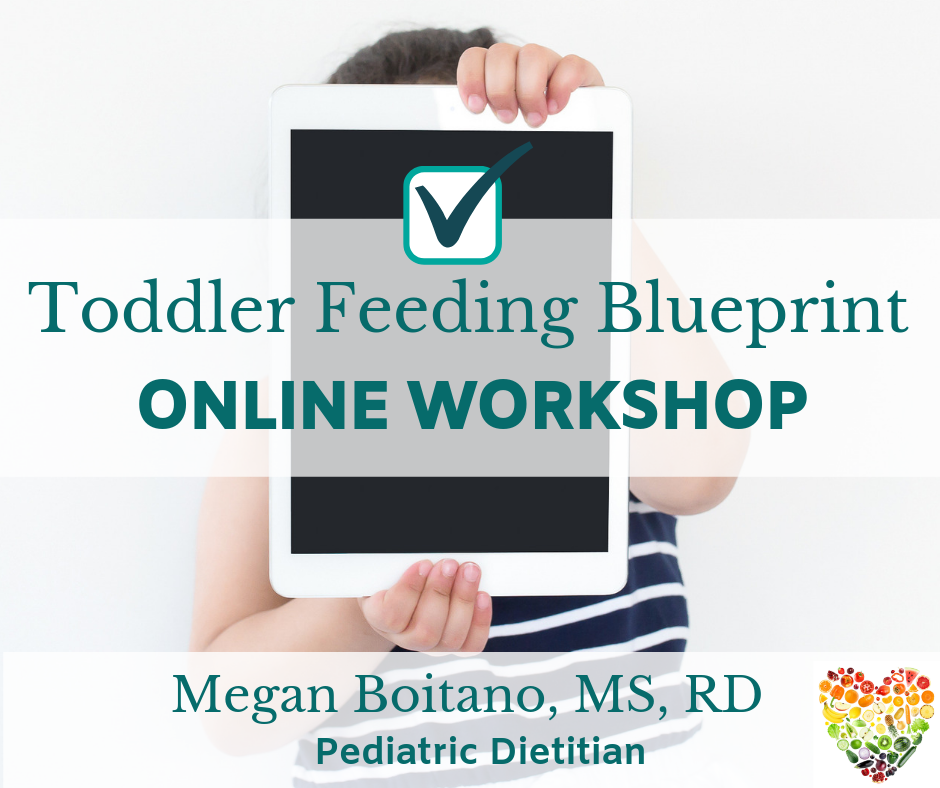If you’re struggling to get your child to try new foods, you’re not alone. More than 50% of parents report picky eating behaviors by the time their child is 2 years old (1).
Many myths surround picky eating. This can cause well-meaning parents to implement strategies that exacerbate the problem.
In this article you will learn which feeding practices and family dynamics contribute to picky eating behaviors, and what to do instead.
What is picky eating?
Unfortunately picky eating is a term that is poorly defined. It generally refers to a broad combination of traits or behaviors.
These traits include poor variety of foods (or food groups) eaten, unwillingness to try new foods, lack of interest in eating, avoidance of foods based on sensory properties and eating very slowly.
Your child may exhibit some or all these feeding difficulties.
The challenge is that these traits and behaviors are lumped into an umbrella term, “picky eating,” when the underlying cause can vary widely. General recommendations you read on the internet or receive from a general practitioner likely aren’t tailored to your child’s specific needs.
Do parents cause picky eating?
Why is it that two children raised in the same household can have dramatically different eating habits?
Eating is a complex skill that requires coordination of many nerves and muscles. It is also highly influenced by sensory elements such as sight, smell and taste. Understanding the basics of child development and how your child learns to eat (or not eat) are fundamentals every parent should learn.
While your child’s unique sensory profile, feeding temperament and developmental stage impact eating, your approach to feeding plays a role as well. Some feeding practices result in negative mealtimes and increased picky eating behaviors (2).
Negative mealtime strategies:
Rewards - Offer your child food (sweets, favorite food) or nonfood (TV, tablet, toy) as a reward for eating.
Disapprove - Show disapproval if your child doesn’t eat.
Withhold - Withhold favorite food or activity as a consequence of not eating. If you don’t eat your meat, you can’t have dessert or go outside and play after dinner.
Clean plate - Make your child finish all of meal before having dessert. Tell your child s/he can’t leave table until food is eaten or tries a bite.
Different Food - Make different food for your child before (or after) the meal if he or she doesn’t like what is being served.
Positive mealtime strategies:
Make meals fun - Arrange food in an interesting way (smiley face) or make meal into a game.
Involve and teach - Teach your child about the food served. Involve your child in planning or preparing the meal.
Allow choice - Allow your child to choose from food served at the meal.
Praise and encourage - Praise child about eating skills or interacting with food.
Model – Sit down and eat healthy foods with child.
Carefully evaluate the approaches you use to feed your child. It is incredibly easy to utilize pressure tactics when you are struggling to get your child to eat. Having clear alternative approaches can help you pivot to more effective strategies.
How is picky eating related to parenting style?
While you were reading the feeding practices above, you may have identified with specific approaches more than others. Some may have struck you as pressuring or more accommodating.
In general feeding practices are grouped into two categories, coercive and supportive.
Coercive – restriction and pressure to eat
Supportive – monitoring, responsibility, modeling and encouraging
Coercive feeding practices are negative meal time strategies and are associated with an increase in picky eating behaviors (2).
The types of feeding practices parents use are closely matched with parenting style. However, parenting style encompasses more than just feeding.
Picky Eating Behaviors Linked with Parenting Styles
The way you interact with your child as well as the feeding practices you use are important determinants of your child’s eating habits. In fact, researchers have found that parenting style is associated with picky and non-picky eating behaviors (2).
Types of Parenting Styles
Parenting styles are used in child development to describe parent-child interactions. Two dimensions are used, control/demandingness and warmth/responsiveness (3). It’s easiest to understand when shown in a chart.
Authoritative parenting is associated with high affection and responsiveness as well as high expectations and limit setting.
Authoritarian parenting employs strict discipline, may be insensitive to child’s emotional needs and may result in motivation by external controls.
Permissive parents may have low expectations for child self-control and set few limits, which has the potential to result in poor self-regulation of behavior.
Do specific feeding practices cause picky eating?
There is a relationship between parenting style and feeding practices (4). The approach you use to feed your child plays a role in the picky (or non-picky) eating behaviors your child exhibits.
Authoritative style parents use encouragement, balance parent control and child autonomy, model healthy food consumption and provide wide variety of fruits and vegetables.
Authoritarian style parents use control, pressure to eat, restriction, rewards for eating, and have lower fruit and vegetable availability.
Permissive style parents are more lenient, provide rewards for eating, less modeling of healthy food choices.
Picky eating behaviors such as eating the same food repeatedly, requiring specific food preparation and anxiety at meals are associated with authoritarian and permissive parenting styles (4).
Non-picky eating behaviors such as trying new foods, eating healthy foods and looking forward to mealtime are associated with an authoritative parenting style.
If you are struggling with a picky eater, efforts that fail to address your family’s specific dynamics are unlikely to be effective.
Your parenting style and feeding practices mesh with your child’s feeding temperament and sensory profile. The feeding relationship is a complex dance and one that is understandably complex to address.
Download the Parenting Style and Mealtime Strategies Quick Reference
This one-page visual includes positive and negative feeding strategies and description of parenting styles.
Summary
Solving feeding issues isn’t about achieving “healthy” meals. It’s about mastering the “how” and healing the feeding relationship – supporting your child to be the best eater they can be.
Rebuilding a feeding relationship isn’t about arranging food on a plate in cute ways, lists of recipes to try or foods to offer.
It means evaluating your parenting style and getting your spouse or other caregivers on the same page. It is about offering yourself kindness and non-judgement as you work to understand and improve your feeding practices and family dynamics.
Next Steps:
Ready to take a deep dive and understand the keys to successful feeding? Register for my Toddler Feeding Blueprint workshop. Attend live or watch the replay video from the event.
References:
1. Carruth, BR et al, Prevalence of picky eaters among infants and toddlers and their caregivers’ decisions about offering new food. J Am Diet Assoc 2004;104(Suppl 1)s57-64.
2. Podlesak AK et al, Associations between parenting style and parent and toddler mealtime behaviors. Curr Dev Nutr 2017;1:e000570.
3. Robinson CC et al. Authoritative, authoritarian and permissive parenting practices: Development of a new measure. Psychol Rep. 1995;77:819-830.
4. Hubbs-Tait L et al. Parental feeding practices predict authoritative, authoritarian, and permissive parenting styles. J Am Diet Assoc 2008;108:1154-1161.



